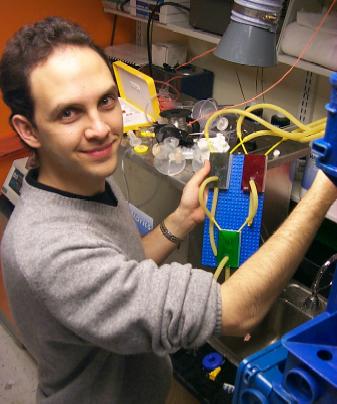Paulo Blikstein
Future of Learning Group
MIT Media Lab
|
Paulo Blikstein
|
|
|
Programmable waterfinal project
Computation is not just about electronics. The idea of the project was to build some devices that could do computation without eletrons. Water was a interesting choice, in fact, Fluidics is a very important field of study that is widely used in aerospace or mission-critical applications, where eletronic control devices don't offer the reliability of cannot support the envoronment. Also, military technologies use Fluidics in order to prevent malfunction in a nuclear war, when eletric devices cease to work.However, the idea was not to send people to space or to control missiles, but rather make a device that could help people build computation with their own hands - and demystifing the computer. To compute, a nice thing to have are boolean operations: but how to implement them with water? I decided to try to use the laser cutter and have multiple layers. The final module looked like this:
It works based on one very simple principle: there are two inputs of water on the top. When just one of them is "on"...
In other words, it's a XOR gate. However, when both are "on", the two jets collide, going vertically down to the "U" piece, that collects the water. In other words, an AND gate.
So, we have two boolean operations in just one device: AND and XOR. So, that's a half-adder!
But it was a long way to get there. My first trial looked like this:
There was leakage all over, so I tried a new design:
It worked better, but its size could not cope with the flow of water. However, the principle worked very well.
This was the third trial, and it worked fine. Then I fabricated many of them, using the laser cutter and acrilic of various colors. I glued a Lego piece under the device, so that it would be easier to assemble small "computers". This is how the 4-bit adder looked like, after many (many!) hours of wet work.
|